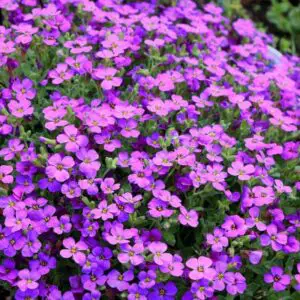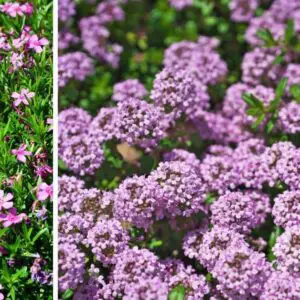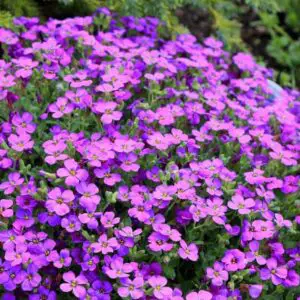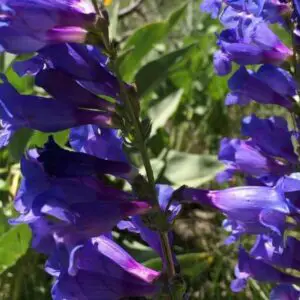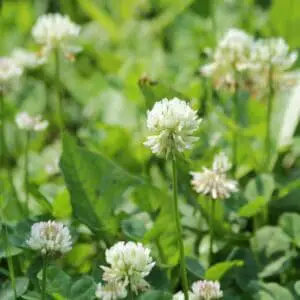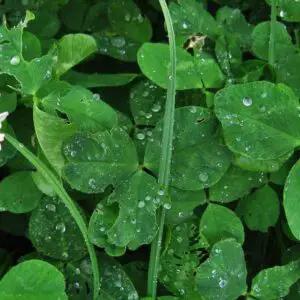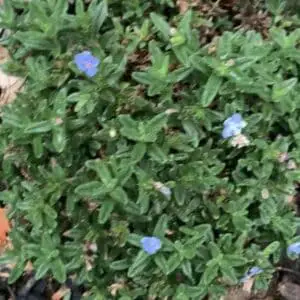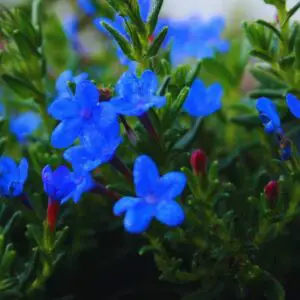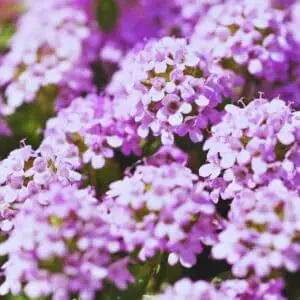Rock cress (false rock cress or Aubrieta) is a flowering ground cover plant. It is a herbaceous perennial perfect as an edging plant or to plant in stone pathways. Creeping phlox (moss phlox) is a low-growing ground cover plant with vibrant flowers.
Both plants look quite similar so you might be wondering what are differences between rock cress and creeping phlox. In this article, I will explain all the differences and similarities between rock cress vs creeping phlox.

Table of Contents
Rock Cress vs Creeping Phlox: Comparison
| Rock Cress | Creeping Phlox | |
| Botanical name | Aubrieta spp. | Phlox stolonifera |
| Common names | Rock cress False rock cress Aubrieta | Creeping phlox Moss phlox Star rock phlox |
| Native area | Europe | North America |
| Plant type | Perennial, herbaceous | Perennial, herbaceous |
| Plant family | Brassicaceae | Polemoniaceae |
| USDA Zone | 4 – 9 | 5 – 9 |
| Bloom time | Spring | Spring Summer |
| Sun | Full or partial sun | Full or partial sun |
| Soil | Well-draining soil | Well-draining loamy soil |
| Soil PH | Acidic Alkaline | Acidic Neutral Alkaline |
| Toxicity | Non-toxic | Non-toxic |
Featured post
Rock Cress vs Creeping Thyme (Everything You Should Know)
Rock cress and creeping thyme are both low-growing, creeper plants. Both plants are great as …

Native area
(False) rockcress originates from southern Europe and central Asia. It can be found throughout Europe as a common garden plant.
Creeping Phlox is native to the eastern United States. This plant grows naturally in woodlands and river banks from the Appalachian Mountains, Pennsylvania south to northern Georgia. Creeping phlox can also be found up north, even in Québec, Canada.
Common names
Rock cress is commonly known as false rock cress or Aubrieta. Please note that there is another plant called rock cress, which is a different plant than this.
Creeping Phlox also has a few common names. Creeping Phlox, moss phlox, and star rock phlox are some of them.
Plant type
Both plants are herbaceous perennials. Rock cress and creeping phlox both are low-growing, ground-hugging plants that are suitable as ground covers.
Rock cress can grow about 4 to 6 inches tall and 12 to 24 inches wide. This plant is hardy in some USDA zones. In extreme winters, it will die back.
Creeping Phlox grow about 6 to 12 inches tall and 9 to 18 wide. It is taller than a rock cress but quite narrow. Creeping Phlox will remain green mostly but will die back in colder winters much like rock cress.
Flowers
Rock cress starts blooming in spring and the flowers are small and have four petals. They come in pink, purple, or white.
Creeping phlox usually start blooming in late spring or in early summer. Phlox flowers are fragrant and have five petals. They are about an inch in diameter and larger than rock cress flowers. Flowers come in purple, pink, or white.


Growing conditions
Sun
Both rock cress and creeping phlox need full sun exposure to thrive. But they will still grow under partial shade. But their growth will be slower, will become leggy, and will produce fewer flowers.
To maximize their growth, plant in a spot with full sun throughout the day. They won’t grow under full shade.
Soil
Rock cress likes alkaline soil with a PH level between 6.5 to 7.5. They naturally grow in rocky, lean soil. So, try to mimic that in your garden. You can add lime to the soil to increase the PH level.
Creeping phlox likes acidic soil and rich soil. It can also grow in neutral and slightly alkaline soil too. The soil must have organic matter such as compost. Mix high-quality compost into your soil before planting.
Drainage is very important for rock cress and creeping phlox. If the soil stay waterlogged, the roots can rot. The soil must be well-draining. Perlite and sand can be used to increase drainage.
Water
Both rock cress and creeping phlox need a moderate amount of water. They prefer moist soil but not wet soil. Water regularly in hot weather especially in summer.
Temperature and humidity
Rock cress prefers cool temperatures. They don’t do very well in hot climates. Creeping phlox on the other hand can handle higher temperatures.
Both plants don’t care much about the humidity. They will do just fine in any humidity level as long as it is not on the extreme ends.

Propagation
Both rock cress and creeping thyme can be propagated by seeds or division.
The division is the way to get new plants faster. This will allow you to get new plants without buying them again and again.
Seeds can also be used to grow new plants. This is especially useful if you want a lot of plants to plant in your garden.
Pests and diseases
Rock cress is susceptible to a fungal disease called downy mildew. Good air circulation and sunlight are preventive measures. If the plant is already infected, cut and remove the infected parts.
Featured post
Creeping Phlox vs Creeping Thyme (Full Detailed Comparison)
Creeping phlox vs creeping thyme? This is a popular comparison a lot of people want …
Creeping phlox is susceptible to powdery mildew. It is another common fungal disease that affects a lot of phlox species. It is important to identify early and destroy the infected parts since this disease can spread rapidly to other plants.
Spider mites can also attack creeping phlox. Bonide Insecticidal Soap is a good product I recommend.
Foliar nematodes are another terrible pest that attacks phlox species. They cause lesions on the leaves. These nematodes live in the soil and are really difficult to get rid of. Diseased plants must be removed and destroyed.
Root rot is another disease both rock cress and creeping phlox can get. Root rot is caused by wet soggy soil. So, increase the drainage and never overwater.

Toxicity
Both rock cress and creeping phlox are non-toxic to dogs, cats, and humans.
